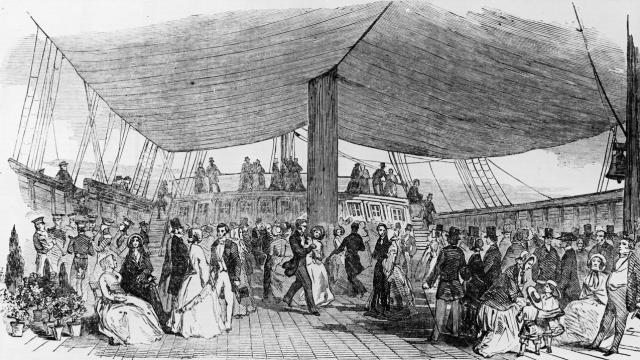This week as an article in the New Yorker detailed how New Zealand has become the hottest spot on the planet for rich Americans to buy property. The New Zealand Herald even discovered that billionaire Peter Thiel, a member of Donald Trump’s transition team, acquired citizenship and owns hundreds of acres there. “Buying a house in New Zealand” is now so common for the wealthy that the phrase has become code for having a backup plan for when the world turns to shit, as one mega rich investor told the New Yorker.
But amazingly, there was a brief period in the 19th century when it looked like New Zealand might join the United States. And there were a lot of perfectly logical reasons for it.
Illustration showing passengers on the deck of the Randolph, one of the first four ships to settle Christchurch in Canterbury, New Zealand in 1850 (Hulton Archive/Getty Images)
New Zealand became a British colony in 1841, but white emigration to the island nation, which was inhabited by the native Maori people, didn’t really surge until gold was discovered in 1861. The gold rush saw New Zealand’s population explode in the 1860s from roughly 99,000 at the start of the decade to 256,000 by 1871. The gold rush brought plenty of Californians, and the colony became inundated with a relatively small but rowdy bunch of Americans who didn’t acknowledge any allegiance to the United Kingdom.
As historian Gerald Horne explains in the 2007 book The White Pacific, “When gold was discovered in Otago in 1861, it was the New Zealanders who attracted attention from California to the point where there was very temporary talk of New Zealand becoming a part of the United States. In both England and New Zealand it was widely believed that an independent New Zealand would gravitate toward the U.S. sphere.”
If the small colony of New Zealand had sought independence from Britain in the 1860s or 70s, Americans could well be calling it a territory, or even a state. After all, there were just 33 American states in 1860.
The New Zealand gold rush also happened to coincide with the beginning of the American Civil War. After the war, there was a Confederate diaspora to the South Pacific — former slave owners in the Southern United States who kept up the slave trade in places like Fiji and Australia. Former American Confederates fled to places like New Zealand, which itself had outlawed slavery, but was just a short hop away from where the trade of human beings was still tacitly accepted.
Anywhere from 60,000 to 120,000 slaves were brought to Australia to work in sugar and cotton fields there between the 1860s and 1900, despite the fact that Australia officially forbade slavery. Trade skyrocketed between the United States and New Zealand in the second half of the 19th century as a result of this increased activity by Californians and Confederates in the South Pacific — traders trafficking in both the gold rush of human beings, driven by British and American demand for cheap cotton, and the literal gold rush.
From Gerald Horne’s The White Pacific:
This mighty ocean was a transmission belt transporting men and women from one distant site to another. Thus, G.N. Parkinson, vice-consul of New Zealand in San Francisco in 1959, recalled that his great-grandfather and his father came to the Golden State in 1848 and earlier had migrated from the United Kingdom to New Orleans and Texas, before moving to Melbourne in 1853 and then later to New Zealand, where his family became engaged in violent conflicts with the indigenes.
Modern citizens of the United States may not think of New Zealand as something that could ever have been “naturally” part of America, but one only need look at the country’s imperial ambitions of the 19th and early 20th century to see that distance was no hurdle.
When you remember that the US controls lands well outside the continental United States, making New Zealand a part of it doesn’t seem too crazy. Take the tiny South Pacific territory of American Samoa, an island 9,674km from the US mainland. It became part of the US in 1900, and by geographic contrast, American Samoa is much closer to New Zealand, with just 3,262km in between them. Hawaii is another geographically distant example.
Talk of New Zealand becoming part of the United States may have been brief, but it wasn’t so weird when you consider America’s expansion west in the second half of the 19th century. Many people headed to California, but some simply continued even further west to find their futures — all the way to New Zealand. And to those Americans at the time it made perfect sense that New Zealand could well become part of the United States.
